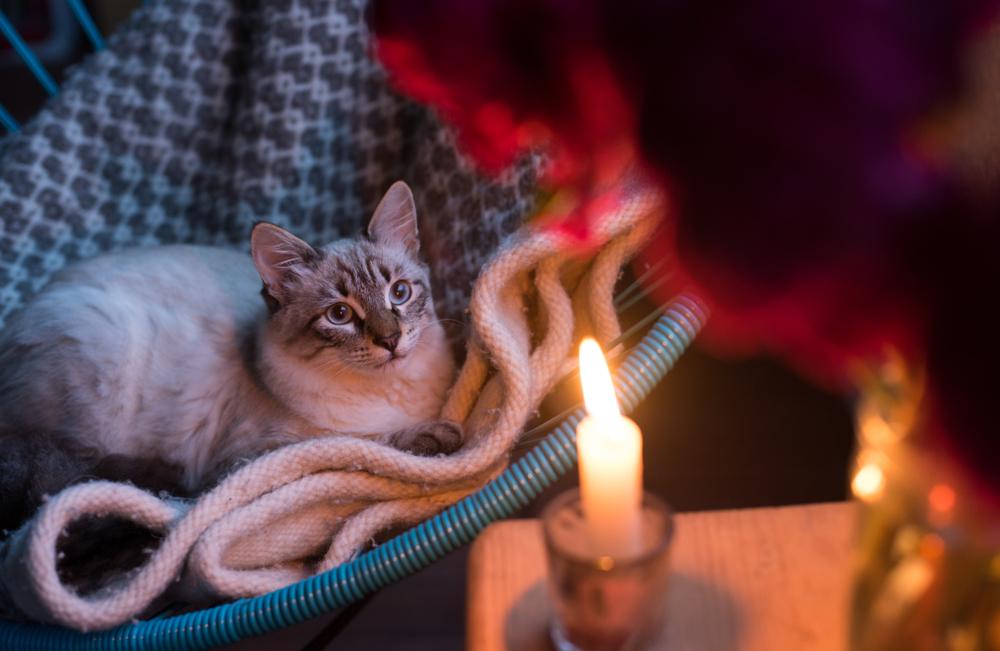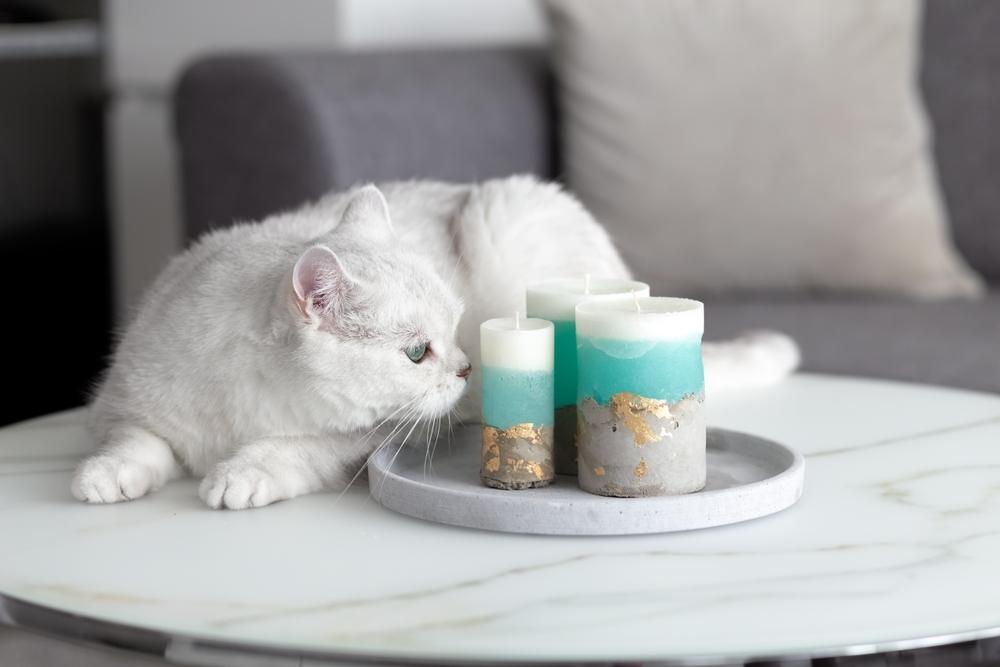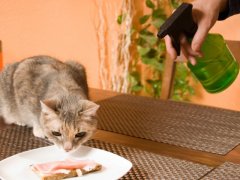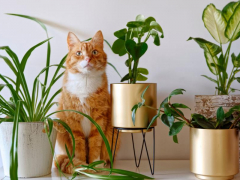
If you love your cat but love candles too, can you have the best of both worlds? Are candles safe to have around cats?
The answer is yes, you can have your cat and candles too, with a little care and attention given to the risks that candles pose. One simple approach would be to use candles in closed rooms or outside. Another would be to consider alternative sources of ambient lighting and home fragrances. Let’s dive into cats and candles a bit more.
What Candles Are Safe for Cats?
Candles have always been popular, and there is a huge variety to choose from. Ranging from cheaper paraffin candles to expensive organic and vegan wax candles, some even contain your favorite fragrance oils, preserved fruits, or foliage. But when it comes to candle safety around cats, the type of wax is important.
Paraffin wax is a petroleum derivative, originally a by-product of the fuel industry, and should be avoided. All smoke contains carcinogens, which are cancer-causing particles. The fumes of paraffin wax are toxic, and while ventilating the room can help, it really is not worth the risk.
Paraffin fumes are not good for you, either. They can cause irritation to the airways of pet owners and pets alike, which might lead to a trip to the doctor or veterinarian.
The United States Environmental Protection Agency warns that burning paraffin products is a source of indoor air pollution which can be incredibly harmful to those inhaling the fumes. The EPA also explains the risks of lead core wicks; wicks made of natural fibers should be used instead.
Other concerns raised by the EPA included additional candle toxins, such as acrolein, formaldehyde, and acetaldehyde, which can lead to lung and heart disease in people. They also warn of the risks of soot from scented candles, but there is no scientific evidence of the potential health risks this poses currently.
If you decide you can’t give up your candles, be sure to look out for natural wax candles that don’t exude toxic fumes. Beeswax, soy wax, coconut wax, and vegetable-based candles are all great choices. They might be a bit more pricey, but for the sake of a few dollars, your health and the health of your cat is worth it.
Are Fragranced Candles Safe for Cats?
Scented candles are great gifts, and most naturally-scented candles are fairly harmless. Many people use them as air fresheners, perhaps to stifle unwanted pet odors. However, cats are very particular creatures, unique in their likes and dislikes.
New scents around the home can be unsettling to cats, particularly if it is a smell that they detest. In fact, strong smells close to your cat’s food or litter box might affect their day-to-day activities and lead to stress-related illnesses such as feline idiopathic cystitis.
Are Scented Candles Bad for Cats?
While your cat will tolerate most scents in small quantities, some odors seem surprisingly unpleasant to many cats. Common examples include citrus, menthol, eucalyptus, peppermint, lemongrass, lavender, rosemary, and thyme. So as not to upset your cat, you might want to avoid candles emitting these fragrances altogether.
Are Candles With Essential Oils Safe for Cats?
Some candles contain essential oils, which can be more problematic. Some essential oils are toxic to cats, but your cat is unlikely to know this, and they might be quite inquisitive about any new and interesting aromas. Toxic oils include bitter almond, wintergreen, citrus, cinnamon, ylang-ylang, and tea tree (melaleuca) oil. The risk is via ingestion or skin contact.
While hot wax can cause burns, products containing toxic oils can cause skin irritation regardless of the temperature. And, while you might think your cat is unlikely to lick a candle, any wax containing essential oils on their fur might be consumed while grooming themselves.
Signs of Toxicity and Additional Risks
Signs of toxicity depend on the essential oil your cat has been exposed to. The most worrying symptoms include vomiting and diarrhea, respiratory issues, liver damage, and neurological signs, such as tremors and balance issues.
The risks that essential oils pose are increased if your cat has access to pure oil. There is likely a higher risk from an essential oil diffuser, an oil or incense burner, or if they are exposed to the fluid from electric fragrance plug-ins. Cats that lick cold oil from burners might experience severe chemical burns to their tongue. The EPA also cites incense smoke as a cause of contact dermatitis and cancer in people.
Also Read: What Scents Do Cats Hate? This List Might Surprise You
Cats and Flames Don’t Mix

Keeping burning candles in closed rooms away from cats is the best way to avoid a potential disaster.
It seems obvious that any open flame is a risk to your cat, but it is easy to forget just how agile and adventurous cats can be. Putting a lit candle on a shelf might seem safe, but cats can reach most high-up spaces if they really want to. New objects in the home that emanate light and a fresh smell will certainly intrigue any cat.
A curious cat can get more than they bargained for if they get too close to a candle. There is a risk they could knock a candle over, or a flame might catch their fur, whiskers, or tail on fire. As with people, burns in animals are very serious injuries, and their fur won’t protect them any more than our clothing will.
Candles Might Trigger Breathing Issues
If your cat has an underlying respiratory condition, candles can be more of an issue. Feline asthma, also known as cat bronchitis or feline lower airway disease, can lead your cat to have bouts of wheezing, coughing, and be short of breath. It can be very alarming and frightening when they have a severe episode.
Triggers for feline asthma include smokey environments, fumes, aerosols, dust pollens, cleaning products, and some foods. Keeping their environment well-ventilated and smoke-free is important. Use candles only in rooms your cat can’t access.
Even cats not known to have asthma can experience irritation of the airways and respiratory problems if exposed to candle smoke. So, keeping your cat away from burning candles is good advice. Remember, always open the windows after using candles. This removes any residual fumes once the flame is put out.
Can I Make Candles Safer for My Cat?

Candles with LED lights are a great cat-friendly alternative to candles with flammable wicks.
It is important to weigh the risks of using candles and work out if there is a safe way to use them without putting your cat in danger. Ensuring you use natural products, such as beeswax candles, and ventilating your room well is a must. Never leave pets alone in a room with a lit candle, no matter how high up you put it.
Even if you supervise your cat, using a glass candle cover or placing the candle in a lantern is also sensible. That way, your cat will struggle to touch the candle even if they try.
Using a heavy-based candle can prevent it from accidentally toppling over. Additionally, some people like to stand candles in a shallow water basin. Hence, any accidents lead to the candle being immersed and the flame quashed immediately.
Alternatively, keep candles for supervised outdoor use only. Or, even better, stick to battery-powered candles and fairy lights. These pet-safe options are super-pretty and long-lasting. Your cat might even enjoy investigating your fake candles while you can be 100% sure they will not be scorching their paws or setting your home alight.
Cats and Candles: The Final Word
In general, natural wax candles emit such low levels of fumes and fragrances (including essential oils) that they are fairly safe when burnt occasionally and for a short time. But, open flames should always be managed carefully, and extra precautions should be taken for those cats with underlying respiratory disease.
Risks increase with frequent and prolonged exposure. Do not use candles containing toxic essential oils. Although the oils are not highly concentrated, it just isn’t worth the risk, and there are plenty more cat-friendly options out there.
Related Conditions:
- Feline Idiopathic Cystitis: Causes, Symptoms, & Treatment







